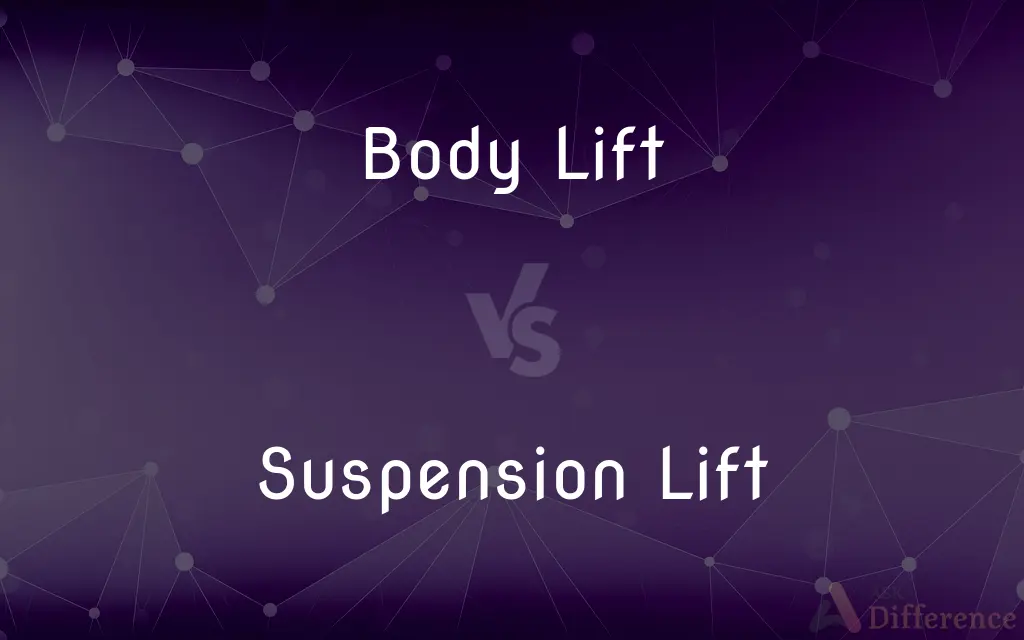Body Lift vs. Suspension Lift — What's the Difference?
By Tayyaba Rehman & Fiza Rafique — Published on September 29, 2024
A body lift raises a vehicle's body above its frame with spacers, affecting appearance and clearance without altering suspension. A suspension lift raises the vehicle by modifying its suspension system, improving ground clearance and off-road capability.

Difference Between Body Lift and Suspension Lift
Table of Contents
ADVERTISEMENT
Key Differences
Body lifts involve installing spacers or blocks between a vehicle's body and frame, effectively raising the body without modifying the suspension or wheels. This type of lift is primarily cosmetic, allowing for larger tires without significantly improving off-road performance.
Suspension lifts, however, involve replacing or extending the springs, shocks, and sometimes the control arms and other components of a vehicle's suspension system. This not only increases the vehicle's height but also enhances its off-road performance by improving ground clearance, articulation, and the ability to use much larger tires.
The main advantage of a body lift is its cost-effectiveness and simplicity. It's less expensive than a suspension lift and doesn't affect the ride quality or handling since the vehicle's suspension geometry remains unchanged. Conversely, suspension lifts, while more expensive and complex to install, offer substantial improvements in vehicle capability, including better handling and stability on rough terrain, and the ability to install larger tires for improved traction and performance.
Body lifts are often limited in how much height they can add, typically no more than three inches, due to safety and aesthetic reasons. Suspension lifts can provide a more significant increase in height, ranging widely from a few inches to over a foot, depending on the vehicle and the type of lift kit used. This makes suspension lifts more versatile for serious off-roading enthusiasts who require maximum ground clearance and suspension articulation.
Installation of a body lift kit can usually be accomplished with basic mechanical skills and tools, as it does not involve altering the vehicle's suspension. Suspension lift kits, however, often require professional installation due to the complexity of the modifications, which can include changes to the suspension, steering geometry, and sometimes the driveline. This can also lead to additional maintenance considerations and adjustments over time.
ADVERTISEMENT
Choosing between a body lift and a suspension lift depends on the vehicle owner's goals. If the aim is to improve the vehicle's appearance or accommodate slightly larger tires without spending a lot of money, a body lift is a suitable choice. For those looking to enhance off-road capability, ground clearance, and overall performance, a suspension lift is the preferred option, despite its higher cost and complexity.
Comparison Chart
Purpose
Raises body for appearance, larger tires
Raises vehicle height, improves off-road capability
Components Modified
Body and frame with spacers/blocks
Suspension system (springs, shocks)
Effect on Ride
Minimal impact on ride quality
Can improve or alter ride quality
Installation Complexity
Relatively simple, DIY-friendly
More complex, often requires professional installation
Cost
Less expensive
More expensive
Compare with Definitions
Body Lift
Cheaper and easier to install than suspension lifts.
Vehicle owners often choose body lifts for an affordable, straightforward modification.
Suspension Lift
Improves off-road capability and ground clearance.
A suspension lift allows for navigating rougher terrain with ease.
Body Lift
Limited height increase, usually up to three inches.
A 3-inch body lift is common for those seeking a moderate height adjustment.
Suspension Lift
Can significantly alter ride quality and handling.
After a suspension lift, a vehicle may handle differently on roads and trails.
Body Lift
Primarily cosmetic, affecting vehicle appearance.
A body lift makes a vehicle look more aggressive without altering its suspension.
Suspension Lift
Allows for a substantial height increase.
Suspension lifts can range from a few inches to over a foot in height.
Body Lift
A body lift uses spacers to raise a vehicle's body above its frame.
Adding a 2-inch body lift to a truck for larger tire clearance.
Suspension Lift
A suspension lift modifies a vehicle's suspension system to raise its height.
Installing a suspension lift kit for better ground clearance.
Body Lift
Does not improve off-road performance.
Despite a body lift, a vehicle's off-road capability remains unchanged.
Suspension Lift
More expensive and complex to install.
Due to its complexity, a suspension lift often requires professional installation.
Common Curiosities
Why choose a suspension lift over a body lift?
Choose a suspension lift for improved off-road capability, ground clearance, and the ability to use larger tires.
Can a body lift affect a vehicle's handling?
A body lift has minimal impact on a vehicle's handling since it doesn't alter the suspension geometry.
How does a suspension lift improve off-road performance?
It increases ground clearance, allowing for larger tires and better handling of rough terrain, obstacles, and water fording.
Are there safety concerns with body lifts?
Safety concerns with body lifts include the potential for increased body roll due to the raised center of gravity, though these effects are generally minimal if the lift is within recommended limits.
How much does a body lift cost compared to a suspension lift?
Body lifts are significantly cheaper than suspension lifts due to the simpler design and fewer modifications required.
Can I combine a body lift with a suspension lift?
Yes, combining both can provide maximum height and off-road performance, but it's essential to consider the potential impacts on handling and safety.
What's the key difference between a body lift and a suspension lift?
A body lift raises the body from the frame for aesthetic purposes, while a suspension lift raises the entire vehicle, improving off-road performance.
Can I install a body lift kit myself?
Yes, with basic mechanical skills and tools, many vehicle owners can install body lift kits themselves.
Does a suspension lift void a vehicle warranty?
It can, depending on the vehicle's warranty terms and the extent of the modifications. It's best to check with the manufacturer or dealer.
What maintenance is required after installing a lift kit?
Regular inspections and adjustments may be needed to ensure components remain tight and aligned, especially after off-road use.
Share Your Discovery

Previous Comparison
Broker vs. Lender
Next Comparison
Green Tea vs. Black TeaAuthor Spotlight
Written by
Tayyaba RehmanTayyaba Rehman is a distinguished writer, currently serving as a primary contributor to askdifference.com. As a researcher in semantics and etymology, Tayyaba's passion for the complexity of languages and their distinctions has found a perfect home on the platform. Tayyaba delves into the intricacies of language, distinguishing between commonly confused words and phrases, thereby providing clarity for readers worldwide.
Co-written by
Fiza RafiqueFiza Rafique is a skilled content writer at AskDifference.com, where she meticulously refines and enhances written pieces. Drawing from her vast editorial expertise, Fiza ensures clarity, accuracy, and precision in every article. Passionate about language, she continually seeks to elevate the quality of content for readers worldwide.













































